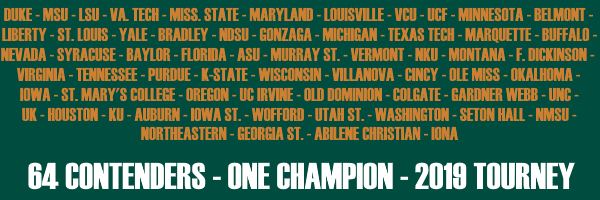






The first full round (64) starts on March 21, 2019.
Welcome to KJ's bracket prediction for the Men's College (Division 1) basketball tourney.
What exactly is this tourney?
The National Collegiate Athletic Association (NCAA, all letters pronunciated, or N-C-Double A) uses a single elimination tournament to determine the National champion for the sport of Men's Basketball. A total of 68 teams are selected, with 8 of those teams playing in a initial round to determine who advances to the first full round of 64 teams. Teams are seeded from a 1-seed (considered one of the best four programs in the nation) to a 16-seed (programs that either just barely scraped in or won an automatic berth but with a lower W-L record, among other factors). Each region (four of them) have in the first round 16 teams playing in the following matchups (1-16, 2-15, 3-14, 4-13, 5-12, 6-11, 7-10 and 8-9). The team that wins the matchup advances, the losing team is out of the tournament, and their season is done. The tournament does NOT reseed teams, so the winner of 1-16 will always face the winner of 8-9, 2-15 faces winner of 7-10, and so on. Once a single team remains from each region, the national semifinals and championship is played at a predetermined site (2019 is in Minneapolis, Minnesota) with the East and West region winners in one semifinal matchup and the Midwest and South region winners in the other semifinal matchup. The winners advance to the final, of which that winner hoists the oval-based trapezoidal trophy and is declared the National Champions of Division 1 Men's collegiate basketball! (Note: There is also a women's tourney with 64 teams that runs roughly the same time as the Men's tournament, and yes, the winners of the women's tournament get the same cool trophy!)
So, how does a team make the tournament in the first place?
There are two ways to qualify for the NCAA men's tournament:
1) Win the conference tournament of the athletic conference the school is a part of. There are 32 conferences in Division I that field men's basketball as a sport, so the conference tournament winner of each of these 32 conferences are guaranteed one of the 68 bids.
2) Be one of the 36 colleges selected for an at-large bid by the NCAA tournament committee. It's rather complicated to explain how the committee arrives at the decision of which 36 teams to admit, and the rationale is different every single year.
After the 68 teams are determined, 60 will be seeded directly into the tournament to play in the Round of 64. The remaining eight will have to play one additional game to gain access into the Round of 64 (usually the last four seeded automatic bids and the last four seeded at-large bids). Four teams will play to earn one of two 11-seeds, the other four teams will play to earn one of two 16-seeds.
What is an upset?
An upset occurs when a lower (higher number) seed manages to defeat a higher (lower number) seed. As 9-seeds are generally 50/50 to beat an 8-seed, a 9 over 8 is generally not an upset. Also, 10-seeds beating 7-seeds (although 10's are double digit seeds) are getting a bit more common, so a 10 over 7 is generally not considered an upset either. For the purpose of this prediction, any college team seeded 11, 12, 13, 14, 15 or 16 winning a matchup is considered a first round upset. Any seeds 6-9 are an upset past the regional semifinal (sixteen teams left) as at that point they would have had to beat a 1-4 seed, and a 5-seed can be considered an upset if they make it to the National Semifinals.
A 16-seed over a 1-seed? That can't possibly happen!?!
IT DID!!! Watch this. (or this, if you want the 8 minute summary of it.) Videos courtesy of the NCAA, I hold no rights to any material in those YouTube videos.
What was the lowest seed to make the National Semifinal, and who was the lowest seed to win it all?
Four teams ranked as an 11-seed made it to the National Semifinal, and the lowest seed to win the title was the eighth-seeded Villanova Wildcats, who won the 1985 tournament as an 8-seed.
Side note: To keep interest in my own predictions, I will make two: one will be an entire bracket all at once, the other is a round-by-round prediction. The Round-by-Round will have seperate pages for each round (except national semis and finals, which shares 1 page). - KJ
What exactly is this tourney?
The National Collegiate Athletic Association (NCAA, all letters pronunciated, or N-C-Double A) uses a single elimination tournament to determine the National champion for the sport of Men's Basketball. A total of 68 teams are selected, with 8 of those teams playing in a initial round to determine who advances to the first full round of 64 teams. Teams are seeded from a 1-seed (considered one of the best four programs in the nation) to a 16-seed (programs that either just barely scraped in or won an automatic berth but with a lower W-L record, among other factors). Each region (four of them) have in the first round 16 teams playing in the following matchups (1-16, 2-15, 3-14, 4-13, 5-12, 6-11, 7-10 and 8-9). The team that wins the matchup advances, the losing team is out of the tournament, and their season is done. The tournament does NOT reseed teams, so the winner of 1-16 will always face the winner of 8-9, 2-15 faces winner of 7-10, and so on. Once a single team remains from each region, the national semifinals and championship is played at a predetermined site (2019 is in Minneapolis, Minnesota) with the East and West region winners in one semifinal matchup and the Midwest and South region winners in the other semifinal matchup. The winners advance to the final, of which that winner hoists the oval-based trapezoidal trophy and is declared the National Champions of Division 1 Men's collegiate basketball! (Note: There is also a women's tourney with 64 teams that runs roughly the same time as the Men's tournament, and yes, the winners of the women's tournament get the same cool trophy!)
So, how does a team make the tournament in the first place?
There are two ways to qualify for the NCAA men's tournament:
1) Win the conference tournament of the athletic conference the school is a part of. There are 32 conferences in Division I that field men's basketball as a sport, so the conference tournament winner of each of these 32 conferences are guaranteed one of the 68 bids.
2) Be one of the 36 colleges selected for an at-large bid by the NCAA tournament committee. It's rather complicated to explain how the committee arrives at the decision of which 36 teams to admit, and the rationale is different every single year.
After the 68 teams are determined, 60 will be seeded directly into the tournament to play in the Round of 64. The remaining eight will have to play one additional game to gain access into the Round of 64 (usually the last four seeded automatic bids and the last four seeded at-large bids). Four teams will play to earn one of two 11-seeds, the other four teams will play to earn one of two 16-seeds.
What is an upset?
An upset occurs when a lower (higher number) seed manages to defeat a higher (lower number) seed. As 9-seeds are generally 50/50 to beat an 8-seed, a 9 over 8 is generally not an upset. Also, 10-seeds beating 7-seeds (although 10's are double digit seeds) are getting a bit more common, so a 10 over 7 is generally not considered an upset either. For the purpose of this prediction, any college team seeded 11, 12, 13, 14, 15 or 16 winning a matchup is considered a first round upset. Any seeds 6-9 are an upset past the regional semifinal (sixteen teams left) as at that point they would have had to beat a 1-4 seed, and a 5-seed can be considered an upset if they make it to the National Semifinals.
A 16-seed over a 1-seed? That can't possibly happen!?!
IT DID!!! Watch this. (or this, if you want the 8 minute summary of it.) Videos courtesy of the NCAA, I hold no rights to any material in those YouTube videos.
What was the lowest seed to make the National Semifinal, and who was the lowest seed to win it all?
Four teams ranked as an 11-seed made it to the National Semifinal, and the lowest seed to win the title was the eighth-seeded Villanova Wildcats, who won the 1985 tournament as an 8-seed.
Side note: To keep interest in my own predictions, I will make two: one will be an entire bracket all at once, the other is a round-by-round prediction. The Round-by-Round will have seperate pages for each round (except national semis and finals, which shares 1 page). - KJ
